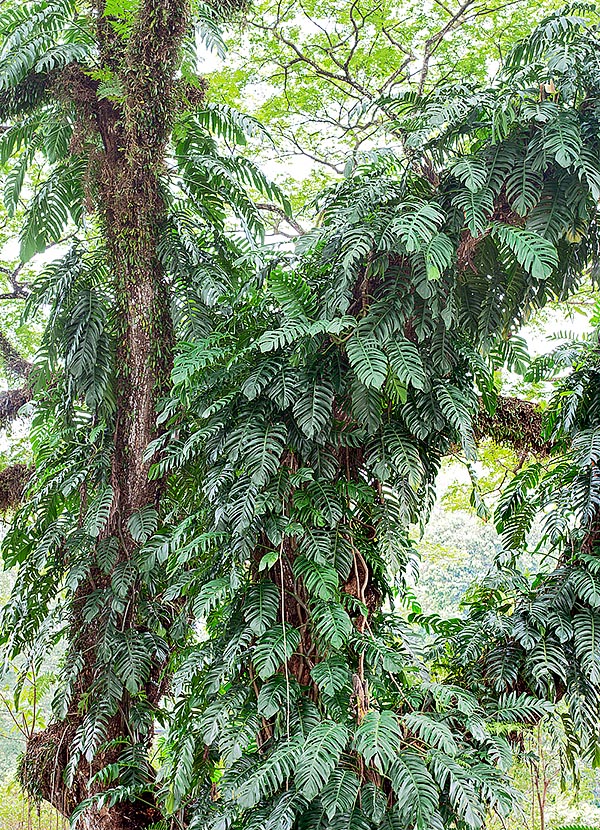Family : Araceae

Text © Pietro Puccio

English translation by Mario Beltramini

Native to South-East Asia, the Epipremnum pinnatum is a climber that can be 15 m tall © Giuseppe Mazza
The name of the genus is the combination of the Greek prefix “ἐπί” (èpi) = over and of the substantive “πρέμνον” (premnon) = trunk, with reference to the climbing posture; the specific name is the Latin adjective “pinnatus, a, um” = feathery, winged, with reference to the pinnate leaves.
Common names: centipede tongavine, devil’s ivy, dragon tail, taro vine (English); long wei cao, qi li nye (China); amlong, dukup, garban, takoline, takotin, tibatib (Philippines); jalu mampang (Java); panniperandai (India); kelampayan (Malaysia); galogalomi, galgalut, gareggi (New Guinea); fue laufao (Samoa); ngot, ngot khao (Thailand).
The Epipremnum pinnatum (L.) Engl. (1908) is an evergreen perennial herbaceous species, prostrate or climbing, very variable, with stems up to 15 m long and of 1-4,5 cm of diameter, little ramified towards the apex, provided at the nodes with robust aerial roots, up to about 1 cm of diameter, that adhere to the trunks and to the rocks on which it leans.
The leaves, on a petiole 18-60 cm long and of 0,5-1 cm of diameter grooved above, are alternate, elliptic-lanceolate with entire margin in the young plants, in the adult oblong-ovate, 10-80 cm long and 5-30 cm broad, coriaceous, from pinnatifid (with lamina subdivided in lobes up to midway between the margin and the central midrib) to pinnatisect (lamina subdivided in lobes up to thecantral midrib). The lobes, 1,5-6 cm broad, arranged regularly, are of intense green colour above, pale below.
The inflorescences, on a 5-20 cm long peduncle of about 2 cm of diameter, are formed by a cylindrical spadix initially white tending with the time to greenish yellow, 8-25 cm long and of 1,5-3,5 cm of diameter, surrounded by a fleshy spathe of yellow to yellowish green colour, 7-25 cm long and 3-12 cm broad.
The flowers, of 0,3-0,6 cm of diameter, sessile, without tepals and arranged in strict contact one to the other on the spadix, are bisexual, but in the lower part where they are only female, but functionally sterile, that have the duty of producing the nectar to attract the pollinating insects.

At times invasive, but with undisputed ornamental value and medicinal virtues © Giuseppe Mazza
It reproduces by seed, but usually and easily by portions of stem devoid of the leaves, put to root in organic loam maintained humid at a temperature of 22-24 °C, and by air layering.
Species amply distributed in nature, from Bangladesh to the Pacific Ocean islands, and introduced for its characteristics highly ornamental in parks and large gardens of many tropical and subtropical countries with warm-humid climate, where in some instances has escaped the cultivation naturalizing and behaving as invasive.
Of fast growth, is usually employed as climber on the trees or for covering rocks and walls, requires a slightly shaded position and draining soils preferably light, rich of organic substance, lightly acidic to neutral.
It is amply cultivated in pot, as drooping or arranged to climb on tutors covered by sphagnum or synthetic material capable to hold the humidity, for the decoration of greenhouses, verandahs and inner spaces, even if little luminous, utilizing a porous and draining loam rich of organic substance, maintained humid, but without stagnations.
Minimum winter temperatures preferably over the 15 °C, even if it can bear some degrees less for a short period. The fertilizations are to be done 1-2 times per year with slow-release hydro-soluble products rich of nitrogen and potassium, the excess of salts may cause damage to the rooting apparatus.
All parts of the plant are irritant if ingested due to the presence of calcium oxalate needles, the contact with the sap can cause dermatitis in most sensitive individuals.
Various parts of the plant are utilized in the traditional medicine of the origin countries for several pathologies, in particular in traumas, fractures, rheumatic pains, abscesses and in the dysentery; preliminary laboratory studies have evidenced in the extracts interesting anticancer properties.
Synonyms: Pothos pinnatus L. (1763); Polypodium laciniatum Burm.f. (1768); Pothos caudatus Roxb. (1820); Pothos pinnatifidus Roxb. (1820); Monstera caudata (Roxb.) Schott (1830); Monstera pinnata (L.) Schott (1830); Pothos decursivus Wall. (1831); Scindapsus caudatus (Roxb.) Schott (1832); Scindapsus pinnatifidus (Roxb.) Schott (1832); Scindapsus pinnatus (L.) Schott (1832); Scindapsus forsteri Endl. (1836); Scindapsus dilaceratus K.Koch & Sello (1853); Scindapsus decursivus Moritzi (1854); Monstera dilacerata (K.Koch & Sello) K.Koch (1855); Rhaphidophora pinnata (L.) Schott (1857); Rhaphidophora pinnatifida (Roxb.) Schott (1857); Epipremnum mirabile Schott (1858); Rhaphidophora caudata (Roxb.) Schott (1860); Rhaphidophora wallichii Schott (1860); Tornelia dilacerata (K.Koch & Sello) Schott (1860); Rhaphidophora cunninghamii Schott (1861); Rhaphidophora vitiensis Schott (1861); Rhaphidophora dilacerata (K.Koch & Sello) K.Koch (1864); Scindapsus bipinnatifidus Teijsm. & Binn. (1866); Epipremnum elegans Engl. (1879); Philodendron dilaceratum Engl. (1879); Rhaphidophora lovellae F.M.Bailey (1897); Rhaphidophora merrillii Engl. (1905); Epipremnum merrillii Engl. & K.Krause (1908); Epipremnum angustilobum K.Krause (1911); Epipremnum robinsonii K.Krause (1912); Epipremnum formosanum Hayata (1915); Rhaphidophora laciniata (Burm.f.) Merr. (1921); Philodendron nechodomae Britton (1926); Rhaphidophora neocaledonica Guillaumin (1937); Epipremnum glaucicephalum Elmer (1938); Rhaphidophora formosana (Hayata) M.Hotta (1970).
→ To appreciate the biodiversity within the ARACEAE family, please click here.
